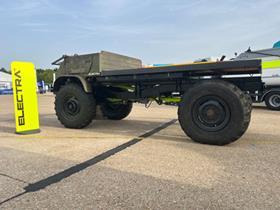Blackburn-based electric truck maker Electra Commercial Vehicles, winner of the 2020 Motor Transport Innovation Award, is continuing to develop its range of battery electric vehicles and looking to move to a bigger factory as it ramps up production. MD Ben Smith tells Steve Hobson about his plans.
A tour of Electra’s factory – or “small shed” as Smith calls it - on the Shadsworth Industrial Estate just off the M65 in south west Blackburn demonstrates just how cramped the site has become as the pioneering EV builder has built up production in the last four years since it was founded by Yorkshire entrepreneur Sid Sadique.
Sadique started out as an apprentice fitter working on Kirklees Council’s refuse collection vehicles and got the idea for Electra when he wanted some batteries for a solar power installation on his house.
“He spoke to a battery supplier and they said they also supplied batteries for trucks,” says Smith. “That’s what started the journey. He also owns a truck leasing business and was having conversations about low emissions zones coming into London. That was the spark of the idea to do this.”
The company now has its eye on a new 38-acre site to give it room to grow as well as provide a base for some of Sadique’s other business interests. Electra plans to build 48 vehicles this year- this is due to a major engineering design change across the platforms - increasing to more than double that in 2024.
“We never say we are going to build thousands,” says Smith. “We are currently scheduled to build 120 next year and that is a realistic figure. It could be more – if someone says they want 100 trucks we can ramp up and build the product anywhere in the world in less than two weeks.”
Focusing on popular chassis for city refuse collection vehicles (RCVs), the platforms used by Electra are the Mercedes-Benz Econic, Iveco Eurocargo, both pictured, and Dennis Eagle Elite. All three manufacturers have given Electra full access to their systems, including the CANbus, so important areas such as automatic braking and lane assist are not affected by the chassis being electrified. It has also more recently electrified an Isuzu N-Series forward cab chassis for smaller GVW platforms.
Electra currently produces mainly rigid electric trucks between 12 tonnes and 27 tonnes GVW, but is now developing a 16-tonne Eurocargo 4x2 tractor unit that could go up to 33 tonnes, with a 19-tonne unit achieving 40 tonnes already available. It is also in discussions to launch the first 12-tonne tractor unit on its already available 12.5-tonne platform.
Electra fits a range of motors but mainly uses a 350kW direct drive motor and an active liquid cooling system, pictured, to keep the batteries within a specified temperature range and so improve their performance and life. This also enables fast charging using a 150kW DC supply, a charge rate than can overheat batteries without a cooling system.
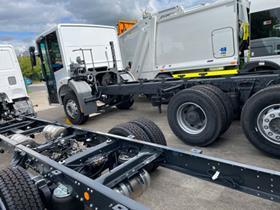
Battery packs are fitted to the customer specification; the 700V batteries are made by Chinese manufacturer CATL, said to be the world’s biggest EV battery maker.
On the day of our visit the factory was pretty quiet, as ironically Electra is suffering from a shortage of wiring looms – not made in Ukraine but by a local firm which in a two-week shut down for staff holidays.
“We used this opportunity to take staff holidays and stock take,” says Smith. “We now are planning to schedule a two week shut down every year for the facility as many factories do the same.”
The first vehicle Electra built in 2018, a 26-tonne RCV, is now termed generation 1. After building 70 of its generation 2 vehicles, Electra halted production in February 2022 to begin designing generation 3. The first prototype was built by July last year with new metalwork, batteries, charger, compressor, steering and wiring looms, and production of the new version began in October 2022.
Vehicle #3 was back at the factory for a refresh after operating with the London Borough of Waltham Forest for three years. “We have brought it up to the same standard as all of our generation 2 vehicles,” says Smith. “It had a handmade loom so that has been replaced, we have modified the batteries, updated the EPTO [electric power take off] and software settings and fitted air conditioning. Nothing major but it now the exact same standard as the newer models.”
Smith does not foresee the day when Electra will build its own chassis as he believes its current suppliers will always be happy to sell it gliders; however plans to build an radically altered platform are afoot.
“We are a niche player so even though they have their own electric products coming they will carry on supplying us,” he says. “We can do an Econic with 140kW or 420kW of batteries whereas the eEconic comes with 300kW and that’s it. We can put the batteries on either side or remove from one side, and also do any wheelbase.
“We can build vehicles other people can’t. The Eurocargo isn’t being electrified by Iveco so that gives us the whole range to focus on.”
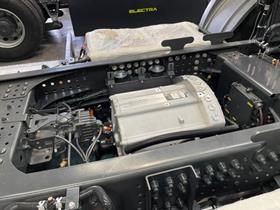
The variety of vehicles operators want electrifying seems endless. There was a 7.5-tonne Isuzu N-Series in the factory being fitted with a break frame for its VCA testing, pictured. It has 140kWh of batteries onboard which have all been squeezed under the cab to leave space at the sides specifically for food waste collection.
Under the UK government’s latest environmental strategy all food waste must be separated into a different bin for collection as it must be recycled rather than sent to landfill or incineration.
“The opportunity for food waste is clearly huge,” says Smith. “There will be 2,000 vehicles required and on this type of vehicle they collect the bins from the side. This whole concept was built around the body which we wouldn’t normally do.”
When completed, the vehicle will be able to run at or 7.5 tonnes or 8.6 tonnes GVW – at 8.6 tonnes it will have a far superior payload than the equivalent diesel.
“The government’s 2-tonne increase in GVW for zero emission platforms has created a problem – they haven’t increased the axle weights so we are scratching our heads as the axles are already at their limit,” says Smith.
In one corner of the factory is Electra’s first tractor unit, pictured, which is termed generation 3.5 as it will carry its batteries in “cassettes” to enable rapid battery swaps. At the recent Road Transport Expo Electra’s engineers spotted a company making interconnectors for battery electrical and cooling connections that will enable batteries to be rapidly replaced rather than recharged.
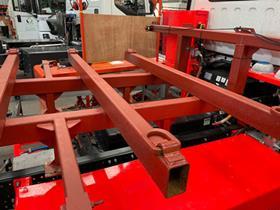
“Everyone is jumping up and down for it,” says Smith. “It is a Eurocargo urban artic and we are not trying to do 300 or 400 miles. It is designed for a market such as supermarkets delivering in the city. It is not a sleeper cab because you can’t go out trunking in it.
“What we are aiming for is to be able to lift the batteries on and off – that is the dream for operations that can’t have a super fast charger.”
The system is also completely scalable allowing more batteries to be fitted if range is more important than payload. The batteries are built into cassettes on the bench rather than on the truck to speed up production and make them easier to swap on and off the truck.
“This is a 210kWh system but it leaves us space for another two packs which takes you to 280kWh,” Smith says. “We can do 420kWh of batteries on three levels if required.”
There is a second chassis awaiting development work that will be fitted with a hydrogen fuel cell range extender supplied by Canadian manufacturer Ballard Power Systems. However Smith expects that the next generation sodium-ion batteries coming in 2024 (see panel) will give enough range and be charged fast enough to potentially avoid the need for battery swaps or fuel cells in many cases.
Electra is currently sticking with a single motor turning a conventional drive shaft, diff and rear axle rather than a gearbox or e-axle. However the technology is moving fast.
“One of biggest conversations we have been having recently is about motors,” says Smith. “The manufacturer of the motor we use now is discontinuing production of the current unit. It has been used in the industry for a long time and it is fantastic motor.
“But now you can get motors from America with the inverter bolted to it in a smaller package. This manufacturer is also bringing out a two-speed version which would enable a truck to run at 40 tonnes up decent gradients.”
The conventional system for EVs uses DC batteries with an inverter to convert the current to AC for the electric motor. While DC motors are available they are less efficient and because they use brushes and a commutator require more maintenance than an AC induction motor. The DC batteries are usually charged with AC mains electricity which requires another inverter to convert it to DC.
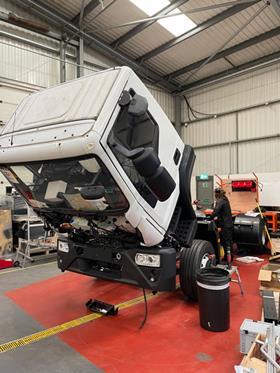
The generation 3 Electra, pictured, has been laid out to be much easier to work on than its previous incarnation.
“The generation 2 has everything built into a frame which has proven difficult to work on in the field,” admits Smith. “We have now developed a unique layout where we have the compressor, steering, 24V batteries, DC/DC and onboard charger which plugs straight into a 32A three-phase supply all boxed in an incredibly accessible configuration to make it easy to work on.
“Before, changing a compressor could have taken six to eight hours. Now it takes 15 minutes. This means we can send our trucks anywhere in the world and they can be easily supported and worked on.”
Although generation 3.5 is just being built Smith’s engineering team is already working on generation 4.
“Most other companies are still on their generation 1 EV but this small company in Blackburn has already learned that people are reluctant to work on these vehicles, so how do we make it easy for them?,” he says. “We are also simplifying production. These used to take six weeks to build but they now take 10 to 11 days and we will get that down to five days in the next couple of months.”
EVs really do need less maintenance than diesels
One of the biggest cost savings when switching from diesel to electric should be in reduced routine maintenance. While the conventional running gear, including brakes, steering, suspension and tyres will still require regular – though not necessarily six-weekly as the Traffic Commissioners often point out – inspection, the electric drive train is virtually maintenance-free.
EVs still use oil for the air compressor – but it needs changing only every 3,000 hours, and Electra advises annual changes. While there is less than a litre, it is not run of the mill 10W40 and a service kit costs around £300. And that is it.
Battery life of up to 14 years
Electra built its first prototypes five years ago and Smith says battery degradation has been minimal.
“We have not even seen 5% degradation,” he says. “Other manufacturers use NMC [lithium nickel manganese cobalt] but we have always used LFP [lithium iron phosphate] batteries.”

These are heavier for the same power capacity but last longer and operate at lower temperatures than NMC batteries, making them ideal for commercial vehicles.
“In a truck they don’t get used and abused like they would in a car or van where they are rapid charged all the time,” Smith says. “These trucks go out in the morning and work steadily all day. We are very happy with what we are seeing on battery degradation.
“When we first started we thought the life would be seven years but we are now looking at can we make them last 14 years. I can guarantee they will be on the road in 10 years and it is likely they will do 14 or maybe even 20 years.”
The generation 2 batteries were good for 3,000 charge/discharge cycles but the new versions can handle at least 5,000 cycles. Smith predicts that the next battery technology on the horizon – sodium-ion (SIB) – will be a game changer for the electric truck market.
“The cost of lithium is already becoming an issue and fast charging them every day isn’t good for them,” he says. “We have only just started fitting DC fast chargers to our trucks so the operators are not fast charging them at the moment. Some trucks are only using 15% of the battery capacity every day so we are saying to the operator ‘don’t charge it every day’ otherwise it will get battery memory.
“A truck that is using less than 20% of its battery capacity can easily be triple-shifted and number of our clients are managing this from vehicles that were not originally designed for it.
“There are councils now saying they may double shift their RCVs and having a quiet, zero emission vehicle means they can do so. Some clients like Lancaster council want to collect rubbish from the university in the evening so that would be a double shift.”
Electra supplies all its vehicles with a built-in charger so the customer does not need to buy a separate charger.
Hydrogen fuel cells on test
In January 2023 Electra completed a four-month trial with Sainsbury’s of a 19-tonne refrigerated electric truck powered by batteries and a hydrogen fuel cell.
The vehicle had multi-temperature insulated body supplied by Solomon, a Carrier Transicold electric refrigeration unit and a Dhollandia tail-lift. The 225kWh battery packs were supplemented by a German-made Proton Motors 44kW hydrogen fuel cell fed from four 5kg hydrogen tanks.
It was used on a 208-mile route from the supermarket’s depot in Sherburn-on-Elmet to Newcastle and back. Data collected from the trial showed that the truck used approximately 65% of its hydrogen capacity per trip, giving it a range of at least 320 miles on one fill of hydrogen. In the trial the best range achieved was 411 miles.
Electrification is not just for work
Smith is something of a petrol head who converted to electrification in the four years he has been MD of Electra. He has “easily” 25 motorbikes but says he never rides them unfortunately. “I have a 1978 Bonneville I brought from Hampshire when I moved to Huddersfield and I think I’ve ridden it once,” he says. “I bought it when I was 25 and I’m 37 now. I used to ride sports bikes like the Suzuki GSXR in my 20s and my dad said I should get an old British bike – he was right as it stopped me riding because none of them work.”
Smith was banned by his partner from buying any more old cars or bikes, but after 18 months he couldn’t resist a couple of Russian ZIL trucks and a German Unimog he found rusting in a hedge recently.“I wanted some bits for a 1960 Unimog and this guy messaged me,” he says. “So I went to have a look and they were the bits I already had but there were also these two ZIL 131s – so to cut a long story short I bought them all!
“We are trying to get the Unimog electrified in time for the Cenex LCV show. It’s still in bits and I’m not sure it will be done in time.”
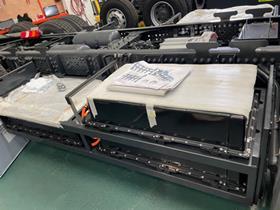
Our interview took place in August, just four weeks before the show, and it looked a tall order based on the state of the project, pictured. It was to be completely rebuilt with an electric drive line, air suspension, custom four-link and axle trussing, power steering, electric heating, modern LCD dash, bench seat and the steering wheel on the right hand side – all of this model were only ever LHD. The truck bed and bench seat hides a full Tesla model 3 battery pack.
“In its original condition it was horrible to drive but this will be a dream to drive,” says “Smith. “I also think it will get a great reaction at shows. Some people are electrifying classic cars but no one is doing old trucks.
“This is really to show our engineering capability and have a bit of fun at the same time.”
He also had a 1947 Jeep, 1976 and 1978 Ford Broncos, a Porsche 356 race car and a Porsche R35 GT-R, all projects in the pipeline.
“I have a dream of converting a barn into a workshop and restoring them all one day,” he says. “I generally buy things which have something wrong with them and rebuild them. The Porsche is wrecked and I want to make into a four-wheel-drive electric race car. It will be fast – 0 to 60 in under two seconds.”

[Update – the Unimog made it to the show - although not running. Smith and one team member who he taught to weld in the four weeks took the vehicle from two chassis rails to a rolling, nearly completed vehicle.
Working many late nights while also trying to run the business Smith and his team mate after metres of welding hand-constructed a truly unique vehicle which had exceptional feedback.]
